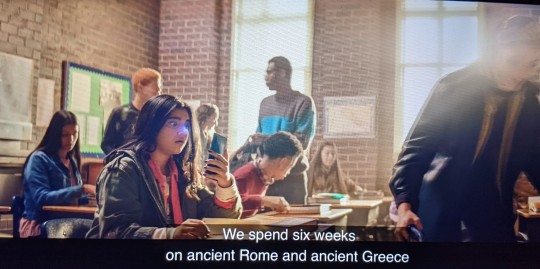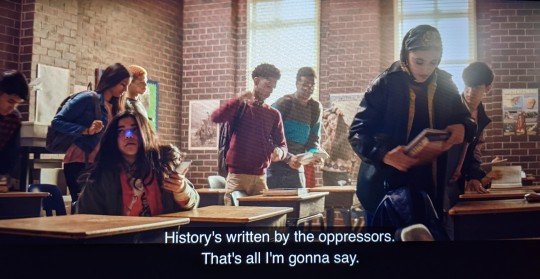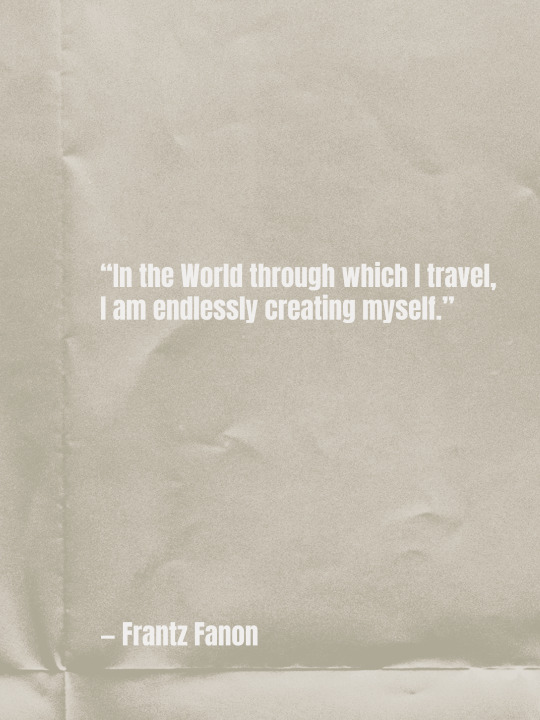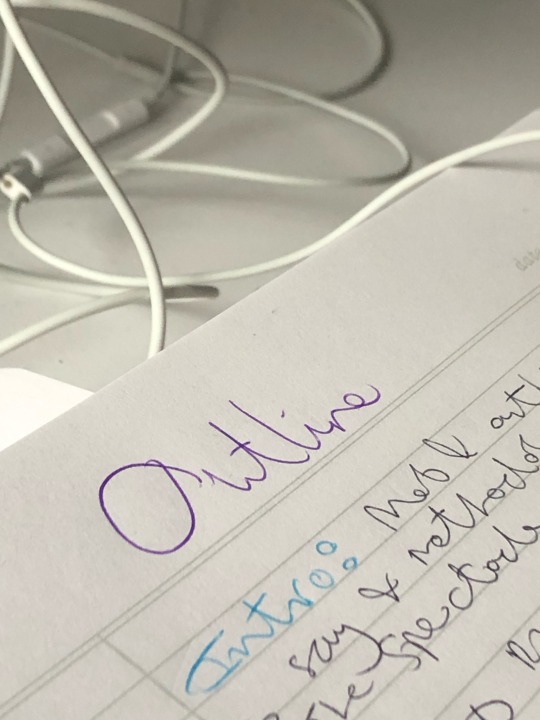#post colonialism
Text



I'm a history buff and this last line is what one of my favorite professors says all the time. I REALLY love this clip.
#marvel#ms marvel#marvel ms marvel#history#oppressors#iman vellani#kamala khan#g willow wilson#nakia bahadir#yasmeen fletcher#post colonialism#colonizers
3K notes
·
View notes
Text

They can never seem to give our country a break. You’d think as the first free slave and black republic they’d be in a better position.
17 notes
·
View notes
Text
Every single empire in its official discourse has said that it is not like all the others, that its circumstances are special, that it has a mission to enlighten, civilize, bring order and democracy, and that it uses force only as a last resort. And, sadder still, there always is a chorus of willing intellectuals to say calming words about benign or altruistic empires, as if one shouldn't trust the evidence of one's eyes watching the destruction and the misery and death brought by the latest mission civilizatrice.
— Edward W. Said, Orientalism.
Follow Diary of a Philosopher for more quotes!
#Culture and Imperialism#Edward Said#book quotes#imperialism#colonialism#quote#quotes#dark academia#non fiction quote#philosophy quotes#gradblr#academia#studyblr#academia aesthetic#post colonialism#post colonial studies#orientalism
12 notes
·
View notes
Text

“In the World through which I travel, I am endlessly creating myself.”
― Frantz Fanon
#Frantz Fanon#Politics#Philosophy#Post Colonialism#psychiatrist#philosopher#revolutionary#author#quotes#tumblr quotes#inspirational#creating yourself#self growth#life quotes
5 notes
·
View notes
Text
Aruna Asaf Ali
Aruna Asaf Ali was born into a Bengali Brahmin family on July 16, 1909. She grew up during a time of great political upheaval in India. Despite societal opposition, she married Asaf Ali, a Muslim leader in the Congress, in 1928, marking the beginning of her active involvement in India's freedom movement.
Following her marriage, Aruna joined various Congress activities, including the Salt Satyagraha, where she was arrested but remained undeterred. She gained widespread recognition for her brave act of hoisting the Congress flag during the Quit India Movement in Bombay.
Even after India gained independence, Aruna continued her tireless efforts for social welfare. In 1954, she founded the National Federation of Women and later served as the first Mayor of Delhi in 1958. Additionally, she established a newspaper to amplify her voice for social change.
Aruna was renowned for her staunch socialist beliefs and unwavering courage in advocating for change. Her contributions to the nation were recognized with several awards, including the prestigious Bharat Ratna in 1997.
Throughout her life, Aruna exemplified the importance of standing up for one's convictions, regardless of the challenges faced.
#aruna asaf ali#indian national federation of women#indian history#post colonialism#indian independence#quit india movement#indian congress#salt satyagraha#women in history#history#indian women in history
5 notes
·
View notes
Text

david damrosch, "world literature in a postcanonical, hypercanonical age"
if you're interested in how colonialism / post-colonialism has affected literature and the english classroom, i highly recommend this essay. Damrosch covers how in the straightforwardly colonial era, white / anglophone literature was pretty much it, and you had top tier stuff (ex. shakespeare) forming the canon, and then more niche stuff (still white guys, tho) making up the 2nd tier.
NOW, tho, we're cramming a lot more lit / culture / langauges into curriculums but not spending any more time studying literature. what that means is that old top tier is still at the top-- now called the hyper-canon bc it has only gained importance. and we've created a counter-canon-- ex. toni morrison and "things fall apart"-- that is comparatively smaller. and more minor, smaller authors of all cultures have shrunk even more into a "shadow canon".
what this creates is a situation where english majors graduate having taken many "race and shakespeare" and "post colonial joyce" classes, and having read "their eyes were watching god" 2.5x, but having no knowledge of minor authors, ESPECIALLY those from minoritized cultures. so now toni morrison + salmon rushdie + chinua achebe are treated as The End-all Be-all Representatives of their respective cultures and canons, bc that's all the classes have time for. and through rubbing elbows with liberal + diverse lits, the Old Whites gain even more canonical power.
i'm condensing and boiling it down and not fully wording it all right, just read it!! it's academic writing but never fear, it is also pretty accessibly and well-written. dm me if you have any issues accessing the pdf and i'll send it to you. brilliant stuff
2 notes
·
View notes
Text
The Trantigone Hub of my Writing
Hiiiii! My name is Antigone,I'm 20, I use They/She pronouns, I'm a researcher and Marxist Historian with an interest in (among many things) Gender/Sexuality/Women's Studies, Post-Colonial Studies, Pedagogical Methods at the Collegiate Level, and Disability Studies (specifically the agency of people with developmental disabilities like Down Syndrome).
I'm also Trans and a really weird lesbian so there's that.
I'm a full-time student, but I'm hoping to use this blog to connect with other like-minded people and have a space to post little bits and bobs I've written about my interests!
3 notes
·
View notes
Photo




When the demand for offence exceeds the supply.
#Stephen Knight#Stray#Kotaku#colonialism#post colonialism#problematics#problematic#problematize#self parody#religious sacraments#wokeness as religion#cult of woke#woke activism#wokeism#woke#religion is a mental illness
39 notes
·
View notes
Text
a personal reflection on decolonization
riel s. | 2022
Tansii kiiya (hello, how are you?) my name is riel starr and I am a Red River Michif artist and academic. my history on his land begins thousands of years ago among the peoples of the great plains, and my written history begins in the late 1600s with my first French ancestors and their unnamed first nations wives. my first First Nations ancestor is an unnamed woman referred to in my grandmother’s family tree as “Cree Woman”. I am Red River Métis on my mother’s side. Our historic Métis family names are Berthelet, Caron, St. Germaine, Dazé, Larivière and Dubois, and we come from the communities of Point à Grouette (now called St. Agathe), St. Norbert, and St. Vital (now modern-day Winnipeg) as well as the historic Batoche, Saskatchewan. My Berthelet ancestors were notable community leaders in Pointe à Grouette and my Caron ancestors including my fifth great uncle jean caron sr. fought in the North West resistance of 1885 at the battle of Duck Lake when he was fifty-two years old. Jean Caron Sr’s house is now a historic site in Batoche. As for myself my mother is a Métis educator and academic and my father is a settler archaeologist-turned-locksmith. I introduce myself in this way, the traditional way of Métis writers to contextualize my family, my knowledge and experiences, as well as my place on this land.
Natually, my native mother and my settler archaeologist father never married and split before I was old enough to form any memories. Museums and history have always been a fascination to me; the Royal Terrell Museum in Drumheller, which I dubbed “the dead dinosaur museum” and the Royal Alberta Museum which I called “the dead mouse museum” after my favourite display. The display was a larger-than-life diorama of a mouse, it’s intestines showing, the organisms that helped decompose the corpse were also displayed, massive daddy long legs, gigantic ants, worms thicker than my arm. The RAM is an interesting place. A few years ago, it was moved into a new building downtown and I could no longer spend hours finding fossils in the limestone exterior of the original museum. The place had changed drastically. As I reminisce on what I loved about the RAM I realize that all the things I disliked were their representations of Indigenous people; the uncanny wax figures with placid skin that did not resemble a single Native person’s skin that I had met. and the artwork they portrayed as artifacts. What makes a beaded bag so different from a Van Dyck if they’re the same age? And honoured the same amount by the people who made them?
Another place of importance growing up was Fort Edmonton Park. Like Heritage Park, Fort Edmonton has costumed interpreters, who teach visitors history as if the interpreters were of that time. In the summer of 2017, my lifelong dream came true, and I became a volunteer costumed interpreter with my mentor Sheldon Stockdale, another Métis person, and we were able to teach our history in the way we felt was right, something deeply important to the Métis people. An experience we had that stands out vividly is working on Fort Edmonton’s 1920 Street, and educating visitors on the history of pemmican, a sort of ancient protein bar made from berries, dried meat, and animal fat. Pemmican was a staple of survival for the Métis, and we were asking visitors to help us in redesigning the packaging for the bar. The historic package had a representation of an Indigenous person on it, a caricature of a race. We asked visitors if turning Indigenous people into mascots should be accepted, and sadly many people didn’t see the problem. Sheldon and I borderline argued with a man who seemed to see no problem in reducing us, the people speaking to him, to caricatures. In a similar vein, someone once gave me Chicago Blackhawk’s stickers when i was six, and not knowing a thing about hockey I asked my mother who the stickers were of. I’m guessing my mother did not want to explain the history of colonization and caricatures of Indigenous people, so she dismissed my question by telling me that the man in the tacky illustration was my ancestor.
Decolonizing art history seems like an impossible task, and perhaps it is. You cannot separate someone like Emily Carr from art history in Canada, however you can change the way you teach her work. Perhaps decolonizing art history means recognizing the ways in which “art history” as a field of study is deeply Euro-centric, and how the way of teaching this history is the same. I took my first semester at AUArts in the fall of 2020 after transferring from MacEwan after completing a two-year diploma at MacEwan University. I had a sculpture class a media arts class an art history class. The more I consider how to decolonize our history the more I understand that it is not the history that can be decolonized, it is the way we are teaching said history. It is the way that so much of our education is taught to us through a colonial lens, rather than a multifaceted history with a multitude of perspectives and peoples contributing until an entire picture is formed.
In the fall of 2020 in my media arts class my professor Kurtis Lesick was discussing an artist, a black artist who had him and others participate in a performance in which in that space the black artist allowed the participants to say the N-word. Rather than describing the piece in the way I just did removing the slur, Kurtis Lesick made the conscious decision to say the N- word twice. A person I had once thought to be an ally of mine, who knew the language of decolonization. Earlier this year a classmate in this class who was also in my sculpture class in the winter of 2022 told me that ‘knowing me has made her a better person’, this woman does not know me, and I do not know her, but I knew her in that moment. I knew that she wanted me to absolve her of her settler guilt. White settlers love referencing Tuck and Yang’s Decolonization Is Not a Metaphor but sometimes I wonder if they truly understand that it is simply not enough to know the language of decolonization, that you must be actively anti-colonial in a field that is built on colonization.
I spent a lot of time at Fort Calgary this semester for my FINA class, critiquing their exhibitions wondering how they can be improved if they can be improved, and I learned that given their budget that it is not possible. Fort Calgary, like other institutions cannot afford to replace their current exhibits and entirely redesign the way they teach history. What they can do is acknowledge the missing pieces, they can acknowledge the gaps they can acknowledge the fact that there’s more than one canon of history. Sometimes I wonder if the mosaic of history is too complex to decolonize; knowing that we will never return to a world like the one that existed pre-colonization. I think about my one classmate who tokenizes me, who knows how to use decolonial language to appear one way, but who never puts those concepts into practice. I think about the settlers who think that decolonization is re-colonizing the Americas but with “the Indians” in charge this time.
I now understand that decolonizing art history cannot happen without first decolonizing institutions. I have learned that we cannot forget that we once taught art history in an i way we cannot forget the way colonization has infiltrated every aspect of the education system down to the teaching styles of each professor. if we forget how colonial art history is in the first place, we will forget why we need to decolonize. Considering the hand that art history is hard in colonization around the world, I consider about the way southeast Asian women’s bodies are talked about in my textbooks versus European odalisque paintings. Brown people’s bodies were inherently sexualized and seen as dirty, while white people’s bodies were adored and deemed Classical.
Maybe colonization is another movement in the worldwide canon of art history. Another period in the bar graph of history- as google images seems to see art history. Perhaps Emily Carr and Paul Gauguin are the faces of this genre. Just as colonization cannot be forgotten among its victims, it cannot be forgotten by its perpetrators, who still believe they are a superior culture and race. Genres of literature such as post-colonial writing from India and Sri Lanka may suggest, there was a period of colonial art and literature, perhaps it is ongoing, possibly dying out, maybe here to stay. There will always be an antithesis, an attempt to view art and art history from a different perspective, and that is how we can decolonize art history.
#i posted this on my artist page but i only use it for professional reasons and i don't wanna share it here unless you're a mutual lolol#riel text#my writing#academia#institutional critique#art writing#decolonization#indigenous#métis#michif#indigenous art#first nations art#FNMI art#art#alberta#calgary#post colonialism#colonialism#canada#land back
7 notes
·
View notes
Text

cassi namoda
5 notes
·
View notes
Text
How to conjure up a picture, for instance, of a town without pigeons, without any trees or gardens, where you never hear the beat of wings or the rustle of leaves-a thoroughly negative place, in short? The seasons are discriminated only in the sky. All that tells you of spring's coming is the feel of the air, or the baskets of flowers brought in from the suburbs by peddlers; it's a spring cried in the marketplaces. During the summer the sun bakes the houses bone-dry, sprinkles our walls with grayish dust, and you have no option but to survive those days of fire indoors, behind closed shutters.
Albert Camus, from The Plague, 10 June 1947
#albert camus#the plague#Oran#algeria#postcolonial literature#literary text#post colonialism#french literature#books and libraries#world literature#quotes#seasons#dark acadamia aesthetic#classic literature#spring#summer#surviving
8 notes
·
View notes
Text
Who are we? We are the global South, that large set of creations and creatures that has been sacrificed to the infinite voracity of capitalism, colonialism, patriarchy, and all their satellite-oppressions. We are present at every cardinal point because our geography is the geography of injustice and oppression. We are not everyone; we are those who do not resign themselves to sacrifice and therefore resist. We have dignity. We are all indigenous peoples because we are where we have always been, before we had owners, masters, or bosses, or because we are where we were taken against our will and where owners, masters, or bosses were imposed on us. They want to impose on us the fear of having a boss and the fear of not having a boss, so that we may not imagine ourselves without fear. We resist. We are widely diverse human beings united by the idea that the understanding of the world is much larger than the Western understanding of the world. We believe that the transformation of the world may also occur in ways not foreseen by the global North. We are animals and plants, biodiversity and water, earth and Pachamama, ancestors and future generations—whose suffering appears less in the news than the suffering of humans but is closely linked to theirs, even though they may be unaware of it.
— Boaventura de Sousa Santos, Epistemologies of the South: Justice Against Epistemicide.
Follow Diary of a Philosopher for more quotes!
#Boaventura de Sousa Santos#quote#quotes#lit#literature#philosophy#colonialism#post colonialism#south america#latin america#central america#philosophy quotes#philosophy quote#dark academia#light academia#anti colonialism#global south
10 notes
·
View notes
Text



|05-06-2022 // 6:00 p.m|
i was away for 6 days in marrakesh and now we’re back with a bang to working full time and beginning my dissertation.
the break was well needed but i’m already so burnt out so i’m trying not to overwhelm myself as i settle into my new job (which is 9-5 but really 6-6) and settle back into college work.
it’s gonna be a very hectic summer 🐝
#college#study#studyblr#studyspo#dissertation outline#notes#lucidaurelius#iced coffee#summer study#masters in women’s studies#masters student#dissertation#sex worker rights#study aesthetic#dark academic aesthetic#dark academia#light academia aesthetic#light academia#summer academia#post colonialism#intersectional feminism#queer theory#motivation#city academia#cottagecore academia#irish student#irish academia#edward said#stuart hall#patricia hill collins
3 notes
·
View notes
Text
Just wanted to remind everybody that today is the last day of the "humanitarian pause" in gaza. Starting from tomorrow Tuesday 7:00am, Israel will go back to carpet bombing gaza.
We need a permanent ceasefire. Keep speaking up!
#palestine#gaza#israel#important#current events#free palestine#ethnic cleansing#free gaza#gaza strip#gaza under attack#text post#israel apartheid#israel is an apartheid state#israel is a terrorist state#gaza under genocide#colonialism
27K notes
·
View notes
Text
youtube
One Hundred Years of Solitude, Official Teaser Trailer, Netflix!
Bonus: Crash Course on the Nobel Prize-winning Novel :)
youtube
youtube
#One Hundred Years of Solitude#gabriel garcia marquez#Cien años de soledad#Literature#nobel prize for literature#Lit#Colombia#South America#Latin America#Youtube#colonialism#post colonialism#neo colonialism#banana republic
1 note
·
View note
Text
Feminist Manifesto
Why decolonize feminism? What are the issues with the status quo? How can men fit into the societally female vision of feminism? How can we fit women of color into the rich, white standard of feminism?
Manifesto (Link to Instagram)
https://www.instagram.com/voices.of.decolonization?igsh=aDBrYWVsMm43OGRj&utm_source=qr
Manifesto (Text Form)
The feminist movement stands at a crossroads, split with internal rifts and disparities. The influence of capitalism has corrupted our cause, giving prominence to the bourgeoisie, who are predominantly white, while suppressing the voices of the proletariat. Nevertheless, we are determined not to allow capitalism or greed in general to dictate the direction of our movement. The moment has arrived to recapture feminism for everyone, placing a spotlight on those who are most severely impacted by patriarchal and capitalist structures.
In this current age of feminism, specifically in the West, we face a grave problem: unilaterality. The movement’s incohesive structure is causing the feminist campaign to lack overall legitimacy due to varying, and even downright incorrect, definitions of feminism and a lack of unity among all women and allies of the movement. Included in the myriad byproducts of this crucial divide are an anti-male sentiment that is embedded in the Western world’s perception of feminism, and a lack of politicization that the movement desperately needs.
Feminism is the advocacy for women’s rights through the equality of the sexes. It can be a source of empowerment and inclusion for all races, genders, and class levels. However, as a result of the world’s societal and cultural differences, it’s evident that many flaws must be corrected to create a united front and change the existing dominant structures that inherently support the patriarchy. One such problem is the radicalization of feminism itself, which is predominantly geared towards affluent, white women who seek to absolve their guilt or put on a front of advocacy for equality. In public discourse, particularly through a well-known show, ‘She-Hulk’, feminism has transformed from a form of support for the voiceless to a disproportionate and incorrect portrayal of extreme, anti-male propaganda in which women aspire to overpower and “destroy the right-wing patriarchy.” Lack of politicization also serves as a hindrance to the movement; as proposed by Bell Hooks, “feminism is for everybody.” and feminism must be political.
A multimodal vision of a radicalized perspective on feminism presents a dynamic framework that transcends traditional boundaries, incorporating diverse mediums of expression to amplify its message. At its core, this vision views feminism not as a monolithic ideology, but as a continually evolving discourse that demands critical engagement and active participation. Central to this perspective is the recognition that the feminist manifesto serves as more than just a declaration of principles; it is a clarion call for women to interrogate and challenge the status quo within the feminist movement itself. By urging women to scrutinize prevailing narratives and power structures, the manifesto empowers them to forge an agenda that is not only inclusive but also reflective of the complexities of women's identities and experiences. Through this process of introspection and action, feminism emerges not as a static ideology, but as a living, breathing force for social change, dedicated to securing women's rightful place and agency within society.
“It is also not enough to have women in positions of power; these women need to acknowledge how capitalism feeds into racism. Under the name of feminism, white women of economic and educational privilege have used their privilege at the expense of Third World women”
-Anais Rivero
Reflection Statement
In contemplating the multifaceted landscape of feminism through a radicalized lens, one cannot help but marvel at the sheer depth and complexity inherent in this discourse. The embrace of multimodal approaches underscores a profound understanding that feminism is not confined to academic papers or political speeches; rather, it permeates every aspect of human experience, demanding expression through various mediums. The feminist manifesto, in this context, emerges as a potent tool—a rallying cry for women to not only challenge external systems of oppression but also to engage in introspection and critique of the very movements meant to liberate them. It serves as a reminder that true progress necessitates continuous self-reflection and a willingness to confront uncomfortable truths within feminist circles.
Moreover, this radicalized vision of feminism encourages women to reclaim agency over their identities and experiences, recognizing that their liberation cannot be achieved through one-size-fits-all solutions. Inviting women to actively participate in shaping the feminist agenda, fosters a sense of ownership and empowerment, reaffirming that feminism is not merely a theoretical construct but a lived reality. Through this manifesto of collective introspection and action, feminism evolves from a static ideology into a dynamic force for social transformation, dedicated to securing justice and equality for all women, regardless of their diverse backgrounds and lived realities.
Our most important creative choice in the production of our manifesto was its method of presentation: numerous posts by an Instagram account. Our reasoning for this, compared to an essay or infographic, was that feminism is too widespread and ingrained in social constructs for a simpler form of media to be effective. By creating visually-appealing posts and using a platform targeted toward a vast audience (particularly younger generations), we can ensure that our messages have greater reach and therefore make a larger impact.
Each member of our team contributed to the production of this manifesto. Kaiya and Bishop were responsible for ensuring that our content contained appropriate (and fiery) language in order to attract and inspire our audience. Jason and Omar served as representatives, reminding the group of deadlines and maintaining consistent progress. Adamma, Terrence, and Kavin took charge of research, finding sources for our manifesto’s content. Adamma and Kaiya were also responsible for visual design, including publication of the Instagram posts. Finally, Maya, Bishop, and Nikita played the skeptic role, verifying our content and recommending changes whenever our message lacked its intended meaning.
Resources
https://www.globalcitizen.org/en/content/sexist-laws-in-the-us-in-2017/?gad_source=1&gclid=CjwKCAjwoPOwBhAeEiwAJuXRh3UqhpLbB03Udf7cdWO15yM_Doasx4VMxrWsAkcRisIfCUddsJTZRhoCv2UQAvD_BwE
https://keough.nd.edu/the-image-and-failure-of-white-feminism/
https://www.plutobooks.com/blog/feminism-is-for-everybody-bell-hooks/#:~:text=I%20have%20wanted%20them%20to%20have%20this%20simple%20definition%20to,Theory%3A%20From%20Margin%20to%20Center.
https://plato.stanford.edu/entries/feminism-political/
0 notes